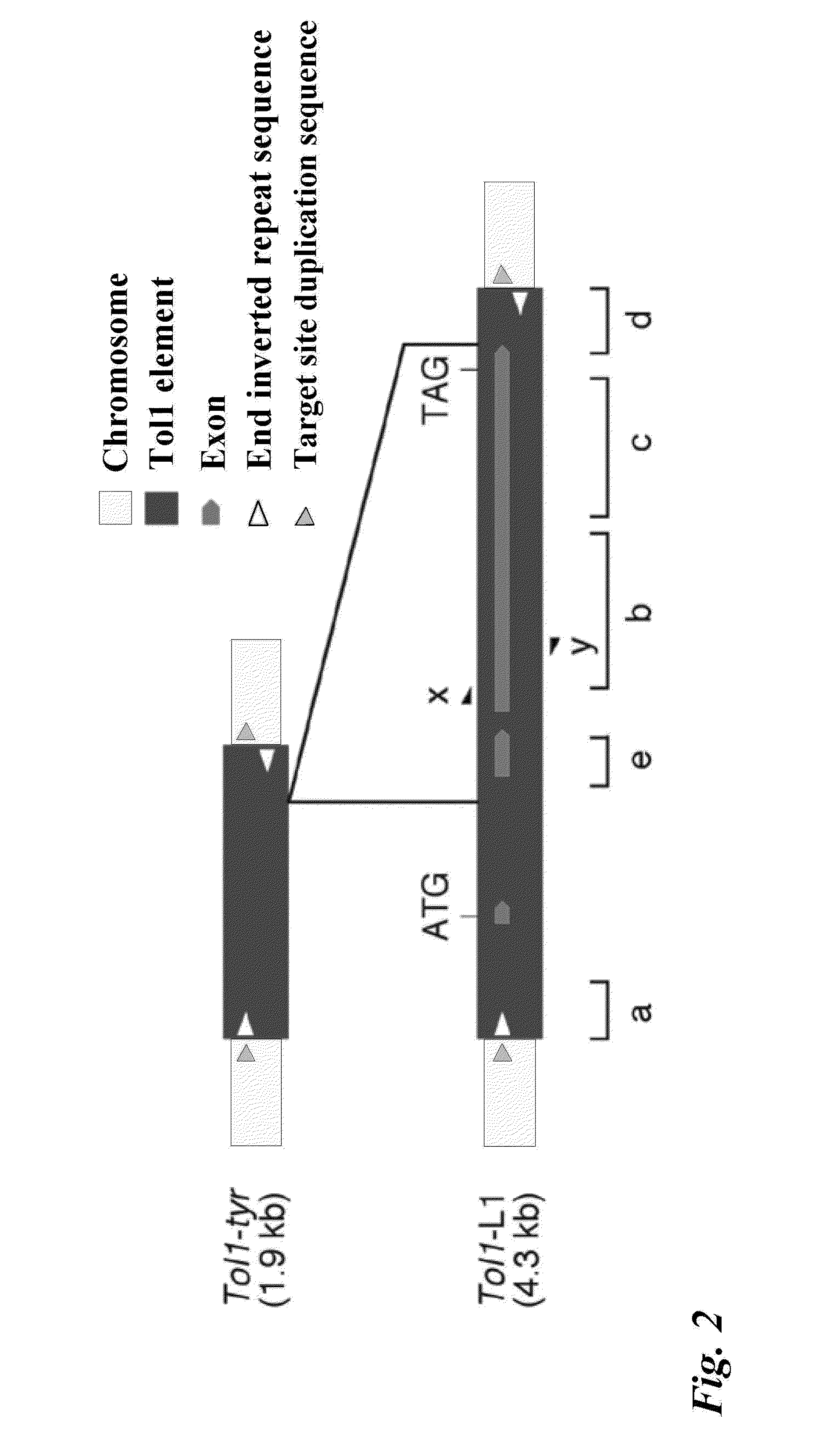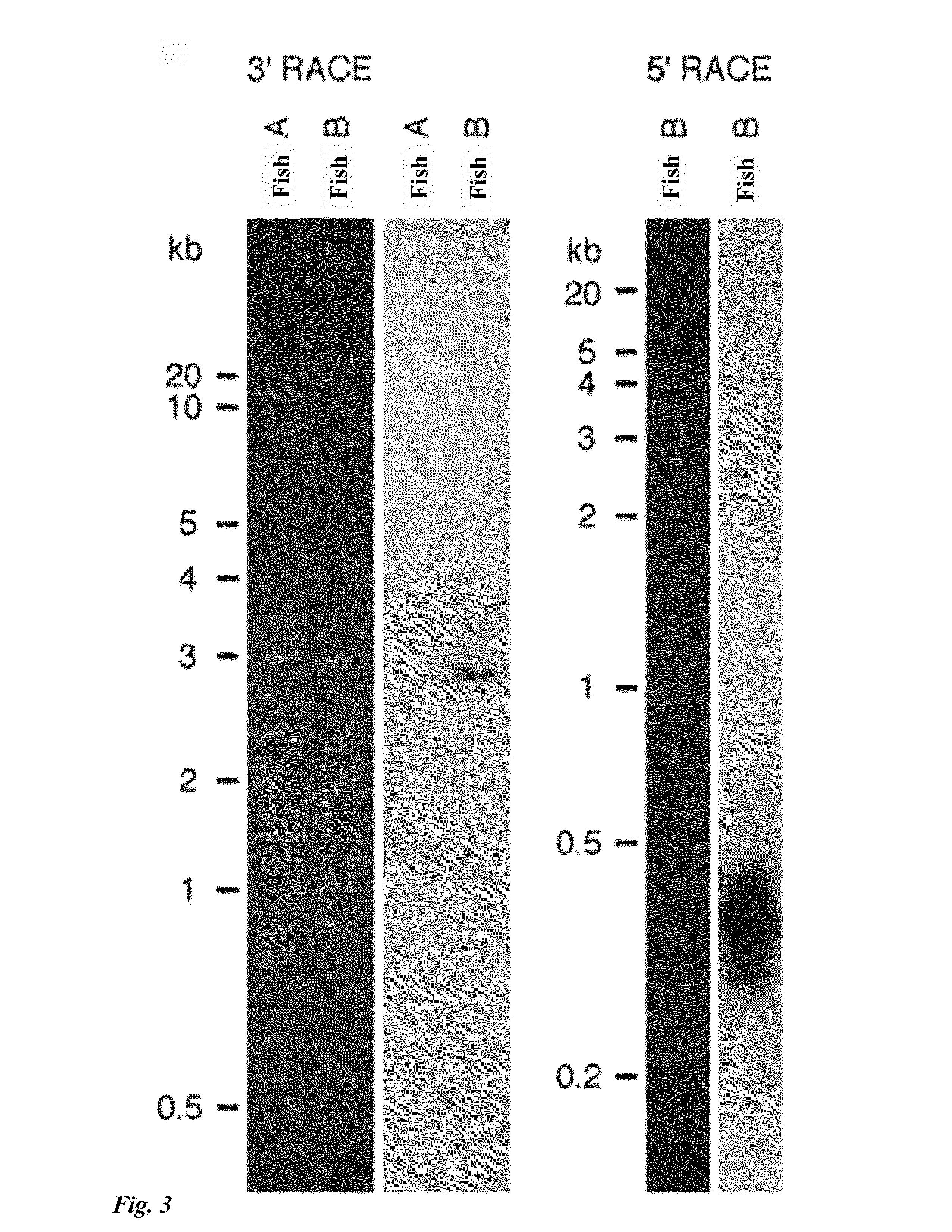Tol1 factor transposase and DNA introduction system using the same
a technology of tol1 factor and introduction system, which is applied in the direction of transferases, viruses/bacteriophages, enzymology, etc., can solve the problems of most vertebrate transposable elements losing their transposition activities, and achieve efficient transposition, enhance the usefulness of tol1 element, and high transposition frequency
- Summary
- Abstract
- Description
- Claims
- Application Information
AI Technical Summary
Benefits of technology
Problems solved by technology
Method used
Image
Examples
example 1
1. Materials and Methods
(1) Fish
[0178]Over 30 years ago, a completely albino individual medaka fish was found in a commercially bred group of fish (Cited document 27). A primary line was established from this individual, which was kept in an experimental laboratory. In this albino mutant line, 1.9 kb of Tol1 element is inserted in the first exon of a tyrosinase gene (Cited document 11). In 2001, an individual fish showing mosaic pigmentation appeared in a subline maintained at Niigata University. Pigmentation did not occur in the primary line maintained in Nagoya University. The primary line was called i1-Tomita and the mosaically-pigmented subline was called i1-Niigata (Cited document 12). These designations are also referred to as subline A and subline B, respectively. The sublines have not previously been bred with other lines.
(2) Database
[0179]The following public databases were used: Genomic project of medaka fish (at the World Wide Web (www) shigen.lab.nig.ac.jp / medaka / genome / ...
example 2
[0227]Using an autonomous copy of Tol1 element (Tol-L1, length 4355 bp, DDBJ / EMBL / GenBank Accession No. AB288091, SEQ ID NO: 4) and a transposable enzyme gene (length 2900 bp, DDBJ / EMBL / GenBank Accession No. AB264112, SEQ ID NO: 3) (Example 1), a Tol1 element is now available as a genetic tool for use in mammals.
[0228]A common feature of transposable elements is a reduction in transposition frequency as the length of an element decreases. Thus, “loading ability” is important when selecting an element. The “loading ability” herein means the “maximum length of a DNA fragment that can be carried by an element.” Tol1 element is expected to be highly useful in this regard. First, the Tol1 element belongs to the hAT family. The hAT family is a group of transposable elements represented by hobo element of Drosophila, Activator element of corn, and Tam3 element of snapdragon (Cited documents 2 and 16). A particular characteristic of this family is a longer whole (complete) length as compare...
example 3
[0271]It was shown in Example 2 that Tol1 is able to carry a long DNA fragment in a chromosome and is an excellent genetic tool. Specifically, it was revealed that Tol1 effectively transposes even if the whole length is as long as 22.1 kb and that Tol1 functions as a vector when the total length of its left and right arms is only 263 kb. Further, it has been shown that Tol1 transposes in human cells and in mouse cells in addition to medaka fish (Example 1; Cited document 15). Therefore, is expected that Tol1 has transposable activity in a wide range of vertebrates.
[0272]A DNA transposable element transfers via “cut and paste.”“Cut” indicates a process of excising an element from a DNA molecule, such as a chromosome, on which the element is currently carried. “Paste” means incorporation of the excised element into the same or another DNA molecule. Herein, detection of a “cut” is easy because sufficient information can be obtained by a PCR analysis focusing on a specific element. Howe...
PUM
| Property | Measurement | Unit |
|---|---|---|
| concentration | aaaaa | aaaaa |
| elongation | aaaaa | aaaaa |
| pH | aaaaa | aaaaa |
Abstract
Description
Claims
Application Information
 Login to View More
Login to View More - R&D
- Intellectual Property
- Life Sciences
- Materials
- Tech Scout
- Unparalleled Data Quality
- Higher Quality Content
- 60% Fewer Hallucinations
Browse by: Latest US Patents, China's latest patents, Technical Efficacy Thesaurus, Application Domain, Technology Topic, Popular Technical Reports.
© 2025 PatSnap. All rights reserved.Legal|Privacy policy|Modern Slavery Act Transparency Statement|Sitemap|About US| Contact US: help@patsnap.com



